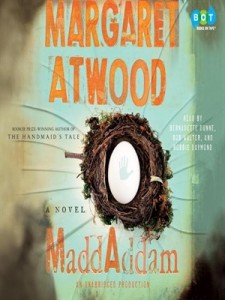This Tuesday, September 3rd, will see the release of the third and final installment of Margaret Atwood’s MaddAddam Trilogy—MaddAddam.
Although I read the book several months ago, I decided to wait to review it until more of you could get your hands on it, so as not to make you hate me (more) for getting it early. Where did this great gift come from, by the way? Let’s just say I have a friend at the bookstore.
 I was able to read the book in almost one setting, as I got hold of it when I was recuperating from my surgery in May. It was absolutely the best thing about being laid up.
I was able to read the book in almost one setting, as I got hold of it when I was recuperating from my surgery in May. It was absolutely the best thing about being laid up.
The MaddAddam triology is a dystopic fiction of a post-apocalyptic world in which a very smart young man has unleashed a virus that has killed almost all of the world’s human population. This smart young man designed another race to take our place–yet they’re vulnerable to the few remaining humans.
Atwood’s vision demonstrates her unique ability to see trends before the rest of us do. She wrote about body image before it was popular to do so, about girl on girl crime before Mean Girls, about the oncoming debt crisis before it hit. The technologies and trends in the trilogy are all based on things that are in development, have been developed, or are logical extensions of things in development. Some of these things are scientific, some are religious, some are ecological, etc.
I’m going to try not to spoil anything in this short review of the end. The most important thing to know is that it’s a good read. Fast, solid, funny, and touching all at once.
Most of the book comes from Toby’s point of view (whom we know from the previous book). We learn more about Zeb’s past and about Adam through her storytelling to the Crakers. In this fashion, some blanks are filled in. And the story does end–you get a sense of how the lives of our characters will end and how life will go on from where we are.
However, not every hole is filled in. While we get a few more fragments of Crake–a few more sightings–we end the series without ever going into his non-neurotypical head. Thus, we still have to put together the pieces of why he did what he did from the pieces Atwood gives us. Did he ever love Oryx? Was that Oryx? Why did he kill her? What did she know? Did she enjoy Jimmy’s company or was she sent to him as a distraction?
I have my own ideas about these questions–as I’m sure you do.
And that’s why I’ll enjoy re-reading these texts from years to come. I have a whole story–but not the WHOLE story. And I’m fine with that. (If I weren’t, I couldn’t be an Atwood reader and scholar.)
Every time I read any of Atwood’s texts, I see new things. (Each time I read Alias Grace, I change my mind about whether she’s guilty or not.)
Her books keep me guessing, keep me working, but they don’t disappoint–I don’t feel like I’m missing any thing just because some viewpoints are incomplete–indeed, that’s what makes her writing so intriguing and so realistic.
A final note. Oryx and Crake focused on the science and the powerful. The Year of the Flood focused on the faith and the powerless. MaddAddam focuses on a world beyond science and faith and their ethical quandries* and on pragmatism and survival. This survival is all about storytelling, which is how knowledge will be passed on, how the Crakers will understand their place in the world, and how future generations will understand their human and Craker progenitors.
*It is not, however, a world of superscience and sorcery, which is what you’re supposed to get after an apocalypse, as I learned from watching Thundar the Barbarian (which, by the way, claimed that the end of the world came in 1994).




